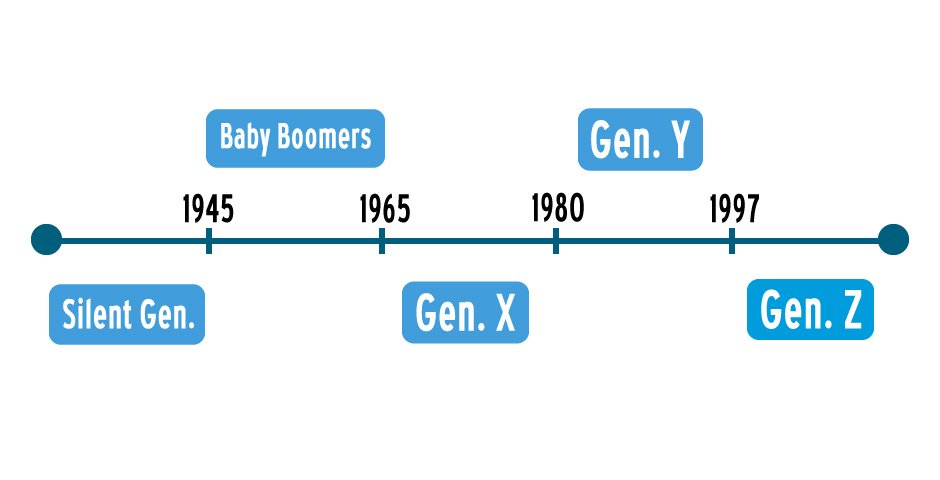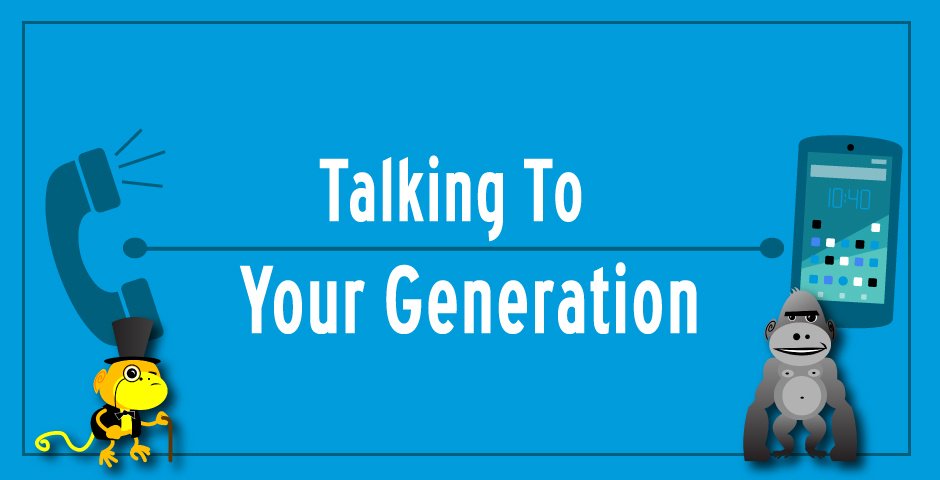We’ve always known that people learn differently. Some prefer verbal interaction (using words, both in speech and writing), while some are more visual (they prefer to use pictures and images), and others prefer to learn through sound and music (aural). In fact, many experts agree there are seven learning styles that guide the way we learn.
That said, it should come as no surprise that the way people consume and respond to marketing content differs greatly as well. One way that brand marketers can get a handle on how best to engage their target buyers is to understand the generational differences in where consumers access information and how they respond to it.
For example:
- Which age groups prefer to shop in brick and mortar settings vs. online?
- Which demographic responds best to telephone calls vs. email?
- Which prefers brands that promote a socially or environmentally responsible message?
How many of you “got” the reference in the title of this blog to the 1966 song My Generation by The Who? If you saw it right away, that probably means you’re a discophile or you grew up in that era—you’re a member of the baby boomer generation.
While a simplistic example, this nonetheless shows how knowing the age demographic of your target buyers can be critically important to connecting with them in this age of content marketing. You could be shooting blanks with your content marketing and not even know it!
THE GENERATIONS

While there are many variations on the theme about which years represent which generation, perhaps the most cited groupings are offered by Pew Research:
- Post-Millennials/Generation Z (born 1997 & later)
- Millennials/Generation Y (born 1981 to 1996)
- Generation X (born 1965 to 1980)
- Baby Boomers (born 1946 to 1964)
- Silent & Greatest Generations (born 1945 or earlier)
It’s important to know which generation (or generations) your target buyers fall into. If it’s more than one, that may mean you need to segment you marketing messages and approaches to reach each particular audience more effectively.
GENERATIONAL PREFERENCES

Silent Generation & The Greatest Generation—Oft forgotten by marketers, these two senior generations still pack considerable buying power. This demographic grew up before, during, and just after World War II and the Korean War. By household, they spend on average around $42,000 a year, compared to Millennials at $47,000. Obviously, they are late adopters to the use of current technologies such as the Internet, smartphones, and tablets.
Still, according to Pew, of the 46 million seniors (ages 65 and up) who currently live in the USA, 67% go online, 42% own smartphones (up from just 18% in 2013), and more than 90% have email addresses. As you might expect, this demographic responds best to traditional marketing methods such as direct mail and print advertising, though some seniors are quite comfortable using the Internet to search for information and buy products. They base most of their purchase decisions on perceived value and prefer bricks and mortar shopping experiences (though they may ask younger relatives or friends to shop online for them).

Baby Boomers—Born after the end of World War II and before the ramp-up to the Vietnam War, this generation consists of nearly 80 million consumers. By household, they spend on average around $59,000 a year, compared to Millennials at $47,000. While many were born before the age of personal computers most have incorporated such technology into their everyday lives in a big way. For example, according to Socialmediatoday.com, 91% of baby boomers have a social media account and they prefer content-heavy platforms such as Facebook over Twitter, and almost all prefer email interaction over instant messaging. This group is less adverse to online shopping than the Silent and Greatest Generations, with 54% typically making an online purchase in the last 30 days. According to Forbes, 50% of all consumer expenditures come from Baby Boomers, who spend around $3.2 trillion annually!

Generation X—In the article, How Each Generation Responds To Marketing Communications, author Venus Tamturk, citing a study by Yes Lifecycle Marketing, reports that this demographic cares less about brand loyalty than other generations. Their motivations for buying are price (55%), quality (45%), and convenience (23%). By household, they spend on average around $66,000 a year, compared to Millennials at $47,000. While most Generation Xers own a laptop, tablet, and or smartphone—and most are on social media and 69% buy items online—they still respond well to direct mail, especially coupons (68% say they use coupons they receive in the mail). According to Pew, the Generation X population is expected to peak at 65.8 million in 2018, and decline slightly to 64.6 million by 2028.

Millennials/Generation Y—This generation came of age during the 2000s and has grown up with technology in the household, at school, and at work. According to an article on Wordstream.com, this demographic represents the largest generation of entrepreneurs and is notoriously soft-hearted, responding well to environmentally-friendly and socially-responsible messages. They do a majority of their shopping online, and with more than $200 billion in annual spending power, they are an audience that marketers cannot ignore. They respond best to authentic, online content and are turned off by spammy robot-like marketing. They also respond well to messages and content built around ratings and reviews and to brand influencers.

Post-Millennials/Generation Z—The newest generation, representing teens and young adults, is still a sizeable force at some 69 million strong. According to an article on CMS-connected.com, more than 80% of Post-Millennials value social media most when it comes to making purchase decisions. TheDrum.com lists the top five social platforms that this generation uses as YouTube (79%), Facebook (78%), Instagram (69%), Snapchat (68%), and Twitter (49%). At 46%, the percentage of this generation that responds to email is smaller than other generations. This is also perhaps the most mobile generation, watching videos on their smartphones and checking emails and messages while on the go. Interestingly, while 79% of this generation report having buying something online in the past month, some 31% reported they prefer to shop in-store because they enjoy the experience—a potential trend that bears watching.
TAKE THE NEXT STEP
Barrel O’Monkeyz can work with you to identify ways you can better connect with your target buyers through generational marketing. We can also provide a free assessment of your current marketing strategies and help you answer the question, “Is my current approach right for my brand?”
You can also check out Barrel O’Monkeyz white papers on a range of topics, from website development, social media, and inbound marketing, to digital marketing, brand development, and design. Each white paper is full of ideas and steps you need to take to turn your ideas into reality.
LET’S GET CREATIVE
Barrel O’Monkeyz is a San Diego-based strategic marketing agency specializing in Sports and Active Lifestyle markets. We serve as a seasoned, outsourced marketing team for companies looking to ramp up sales and launch new products. Our barrel is full of talent and creative arms ready to prove we don’t just monkey around! Contact Barrel O’Monkeyz Today!


Hey there! This is my 1st comment here so I just wanted to give a quick shout out and say I truly enjoy reading through your articles. Can you suggest any other blogs/websites/forums that go over the same topics? Thank you so much!
Maria, I am a fan of socialmediaexaminer.com, websitemagazine.com and hubspot blog. Enjoy! Paul